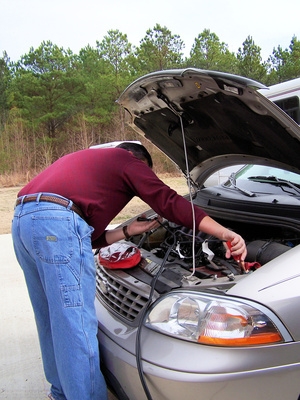
Car batteries work when the chemical reactions in the battery cause electrons to gather at the negative terminal. Turning the key into the "on" position connects a circuit between the negative and positive terminal, causing the electrons to rush from the negative terminal to the positive, providing the spark necessary to power the starter engine and turn the car over. When a car battery dies, it means there is a shortage of electrons gathering at the negative terminal. Car battery chargers work by reversing the flow of electrons from the positive terminal to the negative terminal, eventually causing enough electrons to gather at the negative terminal for a quick current to run from the negative terminal to the positive terminal when the circuit is connected. Testing the effectiveness of a car battery charger requires a field experiment whereby you connect the charger to a dead or dying battery and turning it on.
Clean the terminals of your battery sufficiently with a clean cloth.
Connect the alligator clips of your charger to the terminals of your battery. Connect the negative (black) alligator clip of your charger to the negative terminal of your battery before connecting the positive (red) alligator clip.
Plug your battery charger into a wall socket if it is DC/outlet powered, or turn it on if it is AC battery powered.
Wait two to three minutes or the specified amount of time indicated in the operator's manual that came with your specific battery charger. For most car battery chargers, two to three minutes is sufficient to check whether the charger itself is functional, as it will likely charge the battery enough to turn your car over.